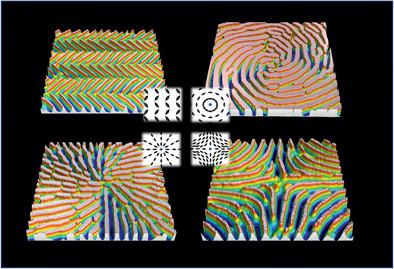Our official English website, www.x-mol.net, welcomes your feedback! (Note: you will need to create a separate account there.)
Translating 2D Director Profile to 3D Topography in a Liquid Crystal Polymer
Advanced Science ( IF 15.1 ) Pub Date : 2021-02-24 , DOI: 10.1002/advs.202004749 Pengrong Lv 1 , Yuxin You 1 , Junyu Li 2 , Yang Zhang 3 , Dirk J Broer 1, 4, 5 , Jiawen Chen 6 , Guofu Zhou 1, 6, 7 , Wei Zhao 1, 6 , Danqing Liu 1, 4, 5
Advanced Science ( IF 15.1 ) Pub Date : 2021-02-24 , DOI: 10.1002/advs.202004749 Pengrong Lv 1 , Yuxin You 1 , Junyu Li 2 , Yang Zhang 3 , Dirk J Broer 1, 4, 5 , Jiawen Chen 6 , Guofu Zhou 1, 6, 7 , Wei Zhao 1, 6 , Danqing Liu 1, 4, 5
Affiliation

|
Morphological properties of surfaces play a key role in natural and man‐made objects. The development of robust methods to fabricate micro/nano surface structures has been a long pursuit. Herein, an approach based on molecular self‐assembling of liquid crystal polymers (LCPs) is presented to directly translate 2D molecular director profiles obtained by a photoalignment procedure into 3D topographies, without involving further multi‐step lithographic processes. The principle of surface deformation from a flat morphology into complex topographies is based on the coupling between electrostatic interactions and the anisotropic flow in LCPs. When activated by an electric field, the LCP melts and is driven by electrohydrodynamic instabilities to connect the electrode plates of a capacitor, inducing topographies governed by the director profile of the LCP. Upon switching off the electric field, the formed structures vitrify as the temperature decreases below the glass transition. When heated, the process is reversible as the formed topographies disappear. By pre‐programming the molecular director a variety of structures could be made with increasing complexity. The height, pitch, and the aspect ratio of the textures are further regulated by the conditions of the applied electric field. The proposed approach will open new opportunities for optical and electrical applications.
中文翻译:

将 2D 导向器轮廓转化为液晶聚合物中的 3D 形貌
表面的形态特性在自然和人造物体中起着关键作用。开发制造微/纳米表面结构的稳健方法一直是一个长期的追求。本文提出了一种基于液晶聚合物(LCP)分子自组装的方法,可将通过光配向程序获得的 2D 分子导向器轮廓直接转化为 3D 形貌,而不涉及进一步的多步骤光刻工艺。表面从平坦形态变形为复杂形貌的原理是基于静电相互作用和LCP中各向异性流动之间的耦合。当被电场激活时,LCP 会熔化并由电流体动力学不稳定性驱动,以连接电容器的电极板,从而产生由 LCP 的指向矢分布控制的拓扑结构。关闭电场后,随着温度降至玻璃化转变以下,形成的结构会玻璃化。加热时,随着形成的形貌消失,该过程是可逆的。通过对分子导向器进行预编程,可以制造出各种复杂性不断增加的结构。纹理的高度、节距和纵横比进一步由施加的电场条件调节。所提出的方法将为光学和电气应用开辟新的机会。
更新日期:2021-04-22
中文翻译:

将 2D 导向器轮廓转化为液晶聚合物中的 3D 形貌
表面的形态特性在自然和人造物体中起着关键作用。开发制造微/纳米表面结构的稳健方法一直是一个长期的追求。本文提出了一种基于液晶聚合物(LCP)分子自组装的方法,可将通过光配向程序获得的 2D 分子导向器轮廓直接转化为 3D 形貌,而不涉及进一步的多步骤光刻工艺。表面从平坦形态变形为复杂形貌的原理是基于静电相互作用和LCP中各向异性流动之间的耦合。当被电场激活时,LCP 会熔化并由电流体动力学不稳定性驱动,以连接电容器的电极板,从而产生由 LCP 的指向矢分布控制的拓扑结构。关闭电场后,随着温度降至玻璃化转变以下,形成的结构会玻璃化。加热时,随着形成的形貌消失,该过程是可逆的。通过对分子导向器进行预编程,可以制造出各种复杂性不断增加的结构。纹理的高度、节距和纵横比进一步由施加的电场条件调节。所提出的方法将为光学和电气应用开辟新的机会。



























 京公网安备 11010802027423号
京公网安备 11010802027423号